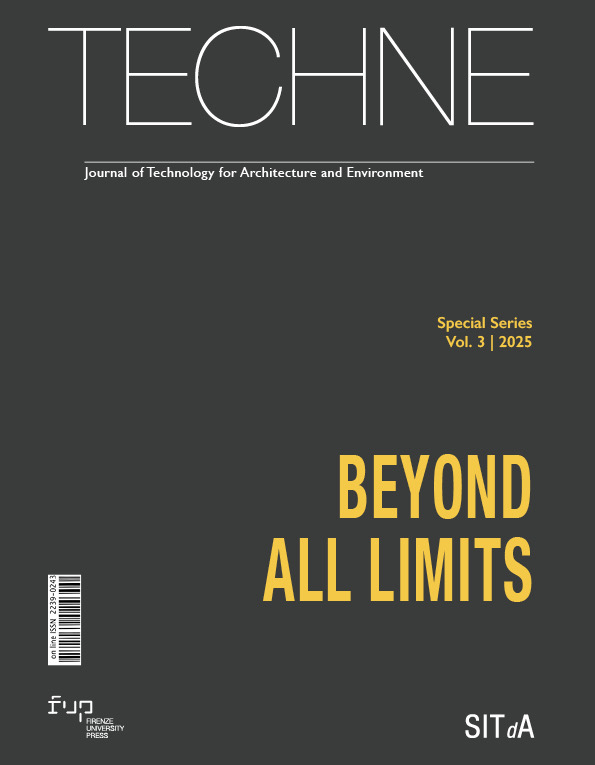Published 2025-07-31
Keywords
- Active city,
- Sports infrastructure,
- Urban resilience,
- Collective well-being,
- Integrated approach
How to Cite
Copyright (c) 2025 Paola Gallo, Rossella Franchino, Caterina Frettoloso

This work is licensed under a Creative Commons Attribution 4.0 International License.
Abstract
This paper demonstrates, through the narration of a direct experience in the field, the potential impact generated by the intervention proposed as a case study, as a driver for the development of the territory in a ‘Healthy City’ perspective, expressing a strong potential for social inclusion and functional and spatial qualification. The research, from which it originated, highlighted the role of the University in supporting the PA in proposing strategic governance actions for the development of the territory. This is achieved through its multidisciplinary competences and its ability to draw on the exchange of visions and contributions provided by the actors involved in order to enhance the available local resources and specificities, and to foster the socio-economic well-being of the community.
Downloads
References
- Alberti, F. (2020), “Civic design per una nuova urbanità responsabile”, BDC. Bollettino del Centro Calza Bini, Vol. 20, No. 1, pp. 25–50. Available at: https://doi.org/10.6092/2284-4732/7543 (Accessed on 30/01/2025).
- Alberti, F. and Radicchi, A. (2022), “The Proximity City: A comparative analysis between Paris, Barcelona and Milan”, TECHNE – Journal of Technology for Architecture and Environment, No. 23, pp. 69–77. Available at: https://doi.org/10.36253/techne-12151 (Accessed on 30/01/2025). DOI: https://doi.org/10.36253/techne-12151
- Allegri, D. and Vettori, M.P. (2018), “Complex sports infrastructure and urban resilience: Technologies and paradigms”, TECHNE – Journal of Technology for Architecture and Environment, No. 15, pp. 165–174. Available at: https://doi.org/10.13128/Techne-22124 (Accessed on 30/01/2025).
- Barton, J. and Pretty, J. (2010), “What is the best dose of nature and green exercise for improving mental health? A multi-study analysis”, Environmental Science & Technology, Vol. 44, pp. 3947–3955. Available at: https://doi.org/10.1021/es903183r (Accessed on 30/01/2025). DOI: https://doi.org/10.1021/es903183r
- Bellaviti, P. (Ed.) (2005), Una città in salute – Healthy Urban Planning a Milano: un approccio e un programma per una città più sana, vivibile, ospitale, Franco Angeli.
- Corburn, J., Flores, E.M., Fuders, F., Howden-Chapman, P., Ke, X., Rozenblat, C., Wang, L., Sun, W. and Zhang, L. (2020), The little book of the health of cities, ImaginationLancaster, Lancaster University.
- Danish Health Authority (2020), How the urban environment impacts physical activity: A scoping review of the associations between urban planning and physical activity. Available at: https://www.dors.it/documentazione/testo/202005/Report_af_urbanenv_2020.pdf (Accessed on 30/01/2025).
- International Science Council (2024), Una prospettiva planetaria per la salute urbana. Available at: https://it.council.science/blog/a-planetary-outlook-for-urban-health/ (Accessed on 25/11/2024).
- James, P., Tzoulas, K., Adams, M.D., Barber, A., Box, J., Breuste, J., et al. (2009), “Towards an integrated understanding of green space in the European built environment”, Urban Forestry & Urban Greening, Vol. 8, No. 2, pp. 65–75. Available at: https://www.sciencedirect.com/science/article/abs/pii/S1618866709000144 (Accessed on 02/06/2024). DOI: https://doi.org/10.1016/j.ufug.2009.02.001
- Key Cities (2022), The healthy city: A futuristic reimagining of the urban economy and built environment – Report, Nexus Planning, Resilience Brokers and WPI Economics. Available at: https://keycities.uk/wp-content/uploads/2022/04/Healthy-Cities-Report_FIN.pdf (Accessed on 13/11/2024).
- Leone, M.F. and Raven, J. (2018), “Multi-scale and adaptive mitigation design methods for climate resilient cities”, TECHNE – Journal of Technology for Architecture and Environment, No. 15, pp. 299–310. Available at: https://doi.org/10.13128/Techne-22076
- Maspoli, R. (2018), “Smart, health city, spazio pubblico e diabete”, The Journal of AMD, Vol. 21, No. 1, pp. 57–62. DOI: https://doi.org/10.36171/jamd18.21.1.10
- MASE – Ministero dell’Ambiente e della Sicurezza Energetica (2024), Città per lo sviluppo sostenibile. Available at: https://www.mase.gov.it/pagina/citta-lo-sviluppo-sostenibile (Accessed on 13/11/2024).
- Occhiuto, M., Pella, R., Sbrollini, D., Bianco, E., et al. (2023), “Manifesto la salute nelle città bene comune. Una roadmap per il benessere e la qualità di vita nelle città”. Available at: https://altis-ops.it/wp-content/uploads/2023/11/ihpb_ist_02_2023_bianco.pdf (Accessed on 02/06/2024).
- Peluchetti, A., Calderoni, M., Lodigiani, A., Giorgi, E., D’Angelo, L. and Cocco, C. (2022), Soluzioni tecnologiche per la decarbonizzazione delle emissioni operative degli edifici. Allegato alla ROADMAP Italiana, GBC Italia, Buildinglife. Available at: https://gbcitalia.org/area-download/roadmap/ (Accessed on 20/11/2024).
- Roos, P.B. (2021), Regenerative-adaptive design for sustainable development: A pattern language approach, Springer. DOI: https://doi.org/10.1007/978-3-030-53234-5
- Sport England (2023), Active design: Creating active environments through planning and design. Available at: https://www.sportesalute.eu/images/studi-e-dati-dello-sport/schede/2023/145-Active-Design-May-2023.pdf (Accessed on 02/06/2024).
- Thomas, Y.F., Boufford, J.I. and Talukder, S.H. (2016), “Focusing on health to advance sustainable urban transitions”, Journal of Urban Health: Bulletin of the New York Academy of Medicine, Vol. 93, No. 1. Available at: https://doi.org/10.1007/s11524-016-0037-x (Accessed on 25/11/2024). DOI: https://doi.org/10.1007/s11524-016-0037-x
- Tjallingii, S. (2015), “Planning with water and traffic networks: Carrying structures of the urban landscape”, in Nijhuis, S., Jauslin, D. and van der Hoeven, F. (Eds.), Flowscapes: Designing infrastructure as landscape, Research in Urbanism Series Vol. III, IOS Press, Delft, pp. 57–80.
- WHO (1948), Costituzione dell’Organizzazione mondiale della Sanità. Available at: https://www.fedlex.admin.ch/eli/cc/1948/1015_1002_976/it (Accessed on 25/11/2024).
- WHO, Regional Office for Europe, Report on urban green space interventions and health: A review of impact and effectiveness. Available at: https://www.who.int/europe/about-us/about-who-europe (Accessed on 20/11/2024).






